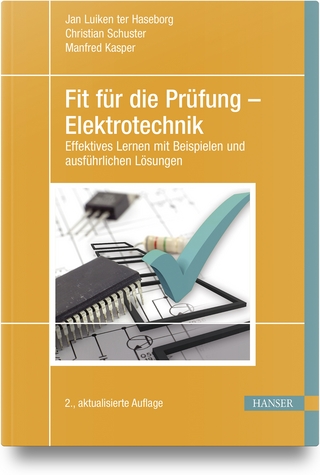
Computer-Controlled Systems
Pearson (Verlag)
978-0-13-736787-0 (ISBN)
- Titel ist leider vergriffen;
keine Neuauflage - Artikel merken
This text provides a balanced survey of theory and practical aspects of computer-controlled systems. Design methods are given substantial coverage.
This book provides a balanced survey of theory and practical aspects of computer-controlled systems. Design methods are given substantial coverage.FEATURES: NEW--Reorganized for greater flexibility: the first nine chapters provide enough material for a short course, while more advanced material is left for later chapters. NEW--Earlier introduction to design of digital controllers (Chapter 4). NEW--Implementation moves up to chapter 9 (from Chapter 14). NEW--Pole placement design is discussed before the deeper design issues of Chapter 6, allowing better discussion of control system design. * Interactive use of MATLAB and Simulink macros to understand the theory. * Extensive pedagogical aids to facilitate understanding. * Worked examples. * Matlab macros. * Problems. * Solutions manual. * Design methods and practical aspects of computer controlled systems are presented.
(NOTE: Each chapter begins with an Introduction section and concludes with a Notes and References section.)
1. Computer Control.
Computer Technology. Computer-Control Theory. Inherently Sampled Systems. How Theory Developed.
2. Discrete-Time Systems.
Sampling Continuous-Time Signals. Sampling a Continuous-Time State-Space System. Discrete-Time Systems. Changing Coordinates in State-Space System. Input-Output Models. The z-Transform. Poles and Zeros. Selection of Sampling Rate. Problems.
3. Analysis of Discrete-Time Systems.
Stability. Sensitivity and Robustness. Controllability, Reachability, Observability, and Detectability. Analysis of Simple Feedback Loops. Problems.
4. Pole-Placement Design: A State-Space Approach.
Control-System Design. Regulation by State Feedback. Observers. Output Feedback. The Servo Problem. A Design Example. Conclusions. Problems.
5. Pole-Placement Design: A Polynomial Approach.
A Simple Design Problem. The Diophantine Equation. More Realistic Assumptions. Sensitivity to Modeling Errors. A Design Procedure. Design of a Controller for the Double Integrator. Design of a Controller for the Harmonic Oscillator. Design of a Controller for a Flexible Robot Arm. Relations to Other Design Methods. Conclusions. Problems.
6. Design: An Overview.
Operational Aspects. Principles of Structuring. A Top-Down Approach. A Bottum-Up Approach. Design of Simple Loops. Conclusions. Problems.
7. Process-Oriented Models.
A Computer-Controlled System. Sampling and Reconstruction. Aliasing or Frequency Folding. Designing Controllers with Predictive First-Order Hold. The Modulation Model. Frequency Response. Pulse-Transfer-Function Formalism. Multirate Sampling. Problems.
8. Approximating Continuous-Time Controllers.
Approximations Based on Transfer Functions. Approximations Based on State Models. Frequency-Response Design Methods. Digital PID-Controllers. Conclusions. Problems.
9. Implementation of Digital Controllers.
An Overview. Prefiltering and Computational Delay. Nonlinear Actuators. Operational Aspects. Numerics. Realization of Digital Controllers. Programming. Conclusions. Problems.
10. Disturbance Models.
Reduction of Effects of Disturbances. Piecewise Deterministic Disturbances. Stochastic Models of Disturbances. Continuous-Time Stochastic Processes. Sampling a Stochastic Differential Equation. Conclusions. Problems.
11. Optimal Design Methods: A State-Space Approach.
Linear Quadratic Control. Prediction and Filtering Theory. Linear Quadratic Gaussian Control. Practical Aspects. Conclustions. Problems.
12. Optimal Design Methods: A Polynomial Approach.
Problem Formulation. Optimal Prediction. Minimum-Variance Control. Linear Quadratic Gaussian (LQG) Control. Practical Aspects. Conclusions. Problems.
13. Identification.
Mathematical Model Building. System Identification. The Principle of Least Squares. Recursive Computations. Examples. Summary. Problems.
A. Examples.
B. Matrices.
Matrix Functions. Matrix-Inversion Lemma. Notes and References.
Bibliography.
Index.
| Erscheint lt. Verlag | 24.1.1997 |
|---|---|
| Sprache | englisch |
| Maße | 177 x 233 mm |
| Gewicht | 802 g |
| Themenwelt | Technik ► Elektrotechnik / Energietechnik |
| ISBN-10 | 0-13-736787-2 / 0137367872 |
| ISBN-13 | 978-0-13-736787-0 / 9780137367870 |
| Zustand | Neuware |
| Haben Sie eine Frage zum Produkt? |
aus dem Bereich


